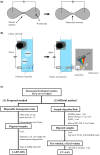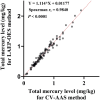Validation of a New Liquid Asymmetric-Electrode Plasma Optical Emission Spectroscopy (LAEP-OES) Method for Measurement of Total Mercury in Tuna
- PMID: 38941490
- PMCID: PMC11532634
- DOI: 10.1093/jaoacint/qsae053
Validation of a New Liquid Asymmetric-Electrode Plasma Optical Emission Spectroscopy (LAEP-OES) Method for Measurement of Total Mercury in Tuna
Abstract
Background: Mercury intake is caused by eating seafood, such as tuna and other predatory fish species. To reduce the health risks of mercury intake, it is necessary to continuously measure and monitor mercury concentrations at fish farms and markets. We have developed a compact system that can detect multiple heavy metals by liquid asymmetric-electrode plasma optical emission spectroscopy (LAEP-OES).
Objective: The validity of the LAEP-OES method for total mercury levels was evaluated using standard solutions, certified substances, and specimens of bluefin tuna and other fish species.
Methods: All specimens were dissolved in 4 M lithium hydroxide solution and then dispensed into a sample reservoir well of the single-use measurement reagent pack. Total mercury levels were automatically measured within 15 min of placement into the dedicated equipment. A total of 102 fish specimens, classified into 10 fish species, were evaluated using the new method and the results were compared to those obtained from validated analytical methods.
Results: LOD (0.02 mg/kg), LOQ (0.07 mg/kg), repeatability (4.0%), intermediate precision (9.8%), and trueness (recoveries 107%) of the proposed method were within satisfactory limits for total mercury levels in fish. Additionally, when using various fish species, the method had a strong positive correlation with the results of cold-vapor atomic absorption spectrometry (CV-AAS, the official method) with Spearman rs = 0.984.
Conclusion: The LAEP-OES method can be used for measuring total mercury levels in bluefin tuna. Total mercury measurement using this new method has the potential to be applied to other fish species.
Highlights: Total mercury levels in fish were measured using our unique analysis system. Pacific bluefin tuna, southern bluefin tuna, and Atlantic bluefin tuna distributed in the Japanese market were analyzed for total mercury in their wild and farmed fish varieties.
© The Author(s) 2024. Published by Oxford University Press on behalf of AOAC INTERNATIONAL.
Conflict of interest statement
Hidenori Takagi and Yoshiaki Shibuta are employees of ARKRAY, Inc. They have no other relevant affiliations or financial interests in relation to the subject matter or materials discussed in the manuscript apart from that disclosed. Michiaki Yamashita does not have any potential conflicts of interest to declare.
Figures



Similar articles
-
Determination of Hg in Farmed and Wild Atlantic Bluefin Tuna (Thunnus thynnus L.) Muscle.Molecules. 2019 Apr 1;24(7):1273. doi: 10.3390/molecules24071273. Molecules. 2019. PMID: 30939866 Free PMC article.
-
Mercury in fish products: what's the best for consumers between bluefin tuna and yellowfin tuna?Nat Prod Res. 2018 Feb;32(4):457-462. doi: 10.1080/14786419.2017.1309538. Epub 2017 Mar 31. Nat Prod Res. 2018. PMID: 28361550
-
[Correlation of fat content and dioxins, total mercury and methyl mercury levels in tuna].Shokuhin Eiseigaku Zasshi. 2010;51(5):258-63. doi: 10.3358/shokueishi.51.258. Shokuhin Eiseigaku Zasshi. 2010. PMID: 21071911 Japanese.
-
Trial for quality control in mercury contents by using tail muscle of full-cycle cultured bluefin tuna (Thunnus orientalis).J Food Prot. 2008 Mar;71(3):595-601. doi: 10.4315/0362-028x-71.3.595. J Food Prot. 2008. PMID: 18389706
-
Lead, cadmium, arsenic and mercury in canned tuna fish marketed in Tehran, Iran.Food Addit Contam Part B Surveill. 2015;8(2):93-8. doi: 10.1080/19393210.2014.993430. Epub 2015 Jan 6. Food Addit Contam Part B Surveill. 2015. PMID: 25443538
References
-
- FAO (2022) The State of World Fisheries and Aquaculture (SOFIA), FAO, Rome, Italy
Publication types
MeSH terms
Substances
LinkOut - more resources
Full Text Sources
Medical

